![]()
LSUE Mardi Gras Photos:
2009 2008 2007 2006
2005
2004
2003
2002
2001
2000
1999
Mardi Gras Archive: Final update of this page
completed in 2009.
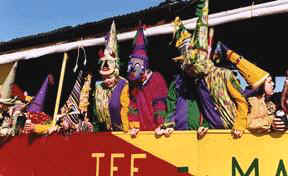 |
 |
For a detailed, scholarly account of the
Tee-Mamou Women's Courir, consult Carolyn Ware's
Cajun Women and Mardi Gras: Reading the Rules Backward (University of
Illinois Press, 2007).
The Tee-Mamou Women's Courir begins on Saturday morning
before Mardi Gras at the Fruge barn northwest of Iota, the same place the men's Mardi Gras
Courir begins on Tuesday. The women receive instructions from the male capitaine, and then
the truck pulling the Tee-Mamou Mardi Gras trailer heads onto the rural highway. The farms
and home that the crew will visit are widely dispersed, so the only way to cover the route
is by truck rather than on horse back.
 |
The route winds through narrow country roads and gravel lanes to farms and rural houses, where the Mardi Gras disembark from the trailer and gather in front of the homeowner's residence to sing the Tee-Mamou Mardi Gras song in French. Once they are welcomed by the homeowner, they dance to the music provided by a band in another trailer, grabbing family members and getting them to join in. |
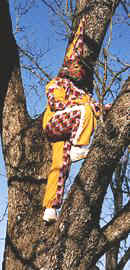 |
Any object in the yard is also likely to become a prop in a prank. Rolling tires around, commandeering a lawn mower, jumping on a trampoline--the Mardi Gras run wild around the yard, while the co-capitaines get out their whips in a mock attempt to restore order. If there's a tree on the property, at least one Mardi Gras is likely to climb it. |
Of course, the real excitement comes if the homeowner has a chicken to offer. Sometimes the chicken is thrown from a roof, sending the Mardi Gras on a frantic scramble. Whoever catches the chicken turns it over to a cocapitaine, who deposits it in a wire cage carried by a pick-up truck.
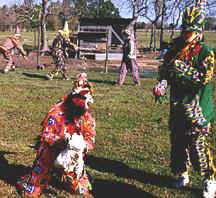 |
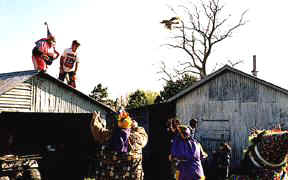 |
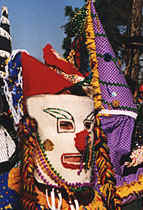 According to Cajun Mardi Gras Masks by Carl Lindahl and Carolyn Ware, the Women's Courir began more than 20 years ago when women whose families were active in the men's courir decided to begin their own run. The book by Lindahl and Ware explains the mask-making techniques, which typically begin with a wire or plastic frame. The needlepoint masks on a plastic frame are a unique Tee-Mamou innovation. Many vivid color photographs of masks are included in the book. |
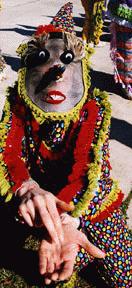 The Tee-Mamou Mardi Gras are expert but polite beggars. Upon receiving cinq sous from the photographer, the Mardi Gras replied "Merci," and rejoined the others. |
After the Tee-Mamou Women's Courir returns to the barn, the Mardi Gras go home to prepare for a Mardi Gras dance that night.
Outsiders can follow the courir and watch as long as they stay out of the way of the Mardi Gras. In 1998, up to a dozen cars rode behind the courir, including photographers from overseas. The procession is led by Acadia Parish Sheriff's deputies.
The 1998 courir was dedicated to Gerald Frugé, who served as capitaine of both the men's and women's courirs in Tee-Mamou for some two decades. After an extended illness, Frugé passed away on Sunday, the day after the women's courir. His son, Todd Frugé, is now capitaine.
Return to Mardi Gras Main Page
Updated March 2001